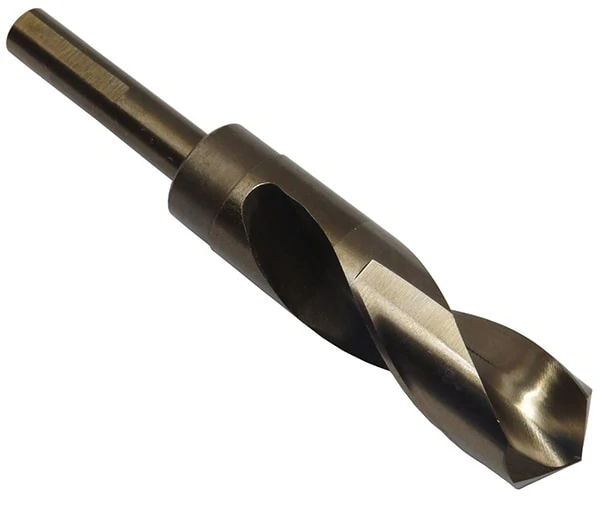From routing wires to drilling pilot holes for fasteners, drill bits are indispensable tools for the professional tradesman as well as the DIY homeowner. In this article, EHT explores a wide range of drill bits to cover the basic types and their various applications.
Drill America D/ACO cobalt drill bits are made of heat-resistant m42 cobalt and ground to a heavy-duty 135° split point. They are similar to high-speed steel, but with more cobalt for improved performance when cutting harder metals such as stainless steel or nickel alloys. Photo © Drill America.
Twist Bits and Common Materials
The standard twist-type drill bit is the most mass-produced drill bit on the market. The geometry and sharpness of the cutting edges determine the performance of the bit. The most common twist bit has a point angle of 118 degrees, which is suited for all sorts of general-purpose tasks. Sharper points, such as a 90-degree angle, provide more aggressive cutting power for materials such as soft plastics. A shallower tip angle, such as 150 degrees, is designed for applications such as drilling steel (but requires a starter hole). The general rule is that harder materials require a large point angle, and softer materials require a sharper angle.
Today’s twist bits are available in several material types. Soft, low-carbon steel bits are inexpensive, but are only used in wood and require frequent sharpening or replacement. High-carbon steel bits are somewhat more durable and can be used in metal or wood, but excessive heat can damage the cutting edge. For better quality and a step up in hardness, high-speed steel bits (HSS) are more tolerant of heat and can drill through softwoods, hardwoods and metal.
Additional materials are now being used to ramp up the performance of today’s metal-drilling bits. Cobalt bits are designed for drilling the toughest materials, like hardened stainless steel, cast iron and titanium. These bits combine HSS with a percentage of cobalt, which results in a bit that resists up to 1,100 degrees Fahrenheit to drill extremely abrasive materials that would normally destroy other bits.
Tungsten Carbide is an extremely hard material that will stay sharp longer than other bits. However, because the material is so brittle, these bits are typically made of HSS and “tipped” with tungsten carbide, so the bits maintain strength and cut down on cost.
Coatings are another hot trend in drill bits. Heat is the single largest hindrance in the life of the bit, and high-tech coatings help resist heat. A Black Oxide coating can double the life of standard HSS bits for all-purpose drilling in wood, plastic, carbon and alloy steels, aluminum and soft cast iron. Titanium Nitride coating is a very hard ceramic material that can dramatically extend the life of the cutting edge when used to coat HSS bits. Titanium-coated bits will last longer than standard Black Oxide bits and cut through more materials.
Diamond powder is another coating used as an abrasive for cutting ceramic, stone and even glass. Diamond bits generate a lot of heat, though, and should be used with water to cool down the cutting process.
Brad-point Bits
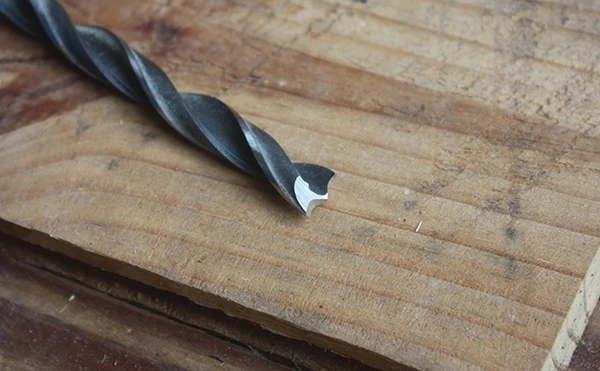
Standard twist bits can wander or skate across the work surface, especially if the bit in question has a wide point angle. In metalwork, drilling a pilot hole can compensate for this, but when drilling in wood, it saves time to use only one bit like a brad-point. Similar to a twist bit, a brad-point bit incorporates a spur with a sharp point into the tip of the bit. The sharp point penetrates the work surface to hold the bit in position while the sharp corners surrounding the spur cut the wood. Additionally, with the outside corners of the brad-point bit leading the cutting action, the wood fibers at the edge of the bore are cut for a cleaner hole. Brad-point bits are also effective in soft plastic, but are not generally used for metal because of their tendency to bind.
Spade Bits
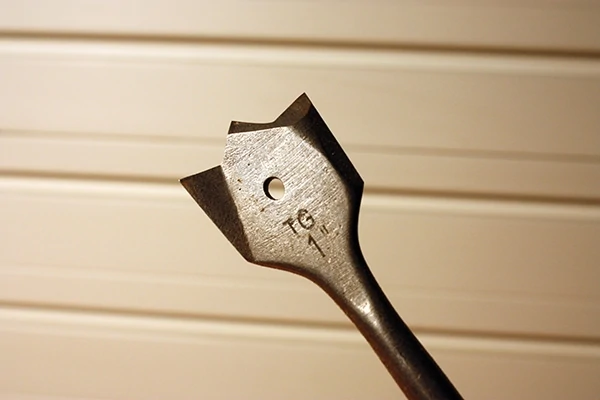
For quick drilling of large holes, spade bits offer plenty of productivity with their paddle-like shape. A typical spade bit is flat with two cutting edges flanking a spur, which guides the trajectory of the drilling. It should be noted that spade bits are intended for rough-in work such as framing, plumbing and electrical work, because their aggressive cutting and high-speed action can leave a splintery hole.
Hole Saws
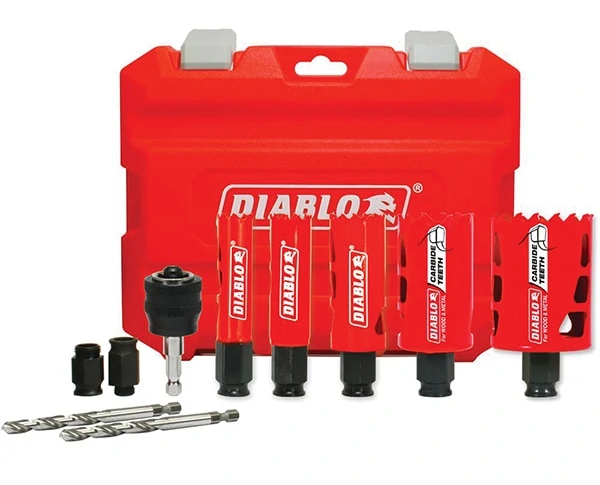
They’re called hole saws, but they fit on a drill—these cup-shaped bits cut out large circles or cores of wood for everything from plumbing to doorknob installation. Quality hole saws feature high-speed steel cutting edges bonded to a steel cup with the added advantage of variable pitch teeth. The repeating pattern of teeth and variable pattern gives smoother cutting in a variety of materials, when compared to the standard wavy pattern of teeth.
Popular new hole saw accessories include quick-change adapter nuts and mandrels that work with almost any manufacturer’s hole-saw cups. (Mandrels are the centering bit and support piece that hold the hole-saw cups.) The quick-change system makes it easy to change cups in seconds and move effortlessly between applications, sizes and materials. Users simply attach the adapters to their cups, drill a hole, and pull back on the mandrel to change cup sizes in seconds. The quick-change system also eliminates the time-consuming task of digging the plug out from the middle of the cup.
Countersink Pilot Bits
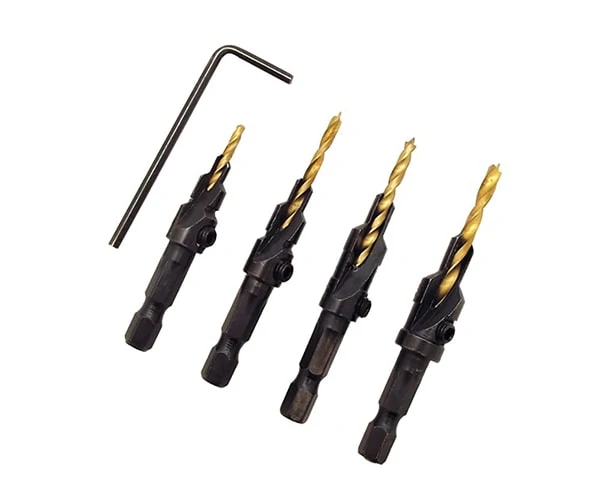
Countersink bits allow you to simultaneously pre-drill screw holes in wood and countersink the holes for recessed screw heads. These bits belong in every toolbox, but are often unduly overlooked by DIY’ers—and the result is split wood when driving the screws. Countersink bits are available in several sizes to match standard screw sizes. Some versions have an adjustable twist bit fitted into the countersink body. To match the bit length to the screw length, just loosen the hex nut on the countersink collar, slide the bit in or out, and then retighten.
Forstner Bits

Named after their inventor, Benjamin Forstner, Forstner bits are the best choice for drilling precise, flat-bottomed holes in wood. Forstner bits have a center spur as a guide and radial cutting edges that shear wood fibers at the edge and bottom of the hole, creating a smooth bore with an exact diameter. They can cut on the edge of a block of wood to create channels, and can also be used to create overlapping holes. Forstner bits require a lot of force to drive them into the wood, so they’re typically used in a drill press. These bits also have no method of clearing wood chips, so they should be retracted periodically to clear the hole.
Step Bits
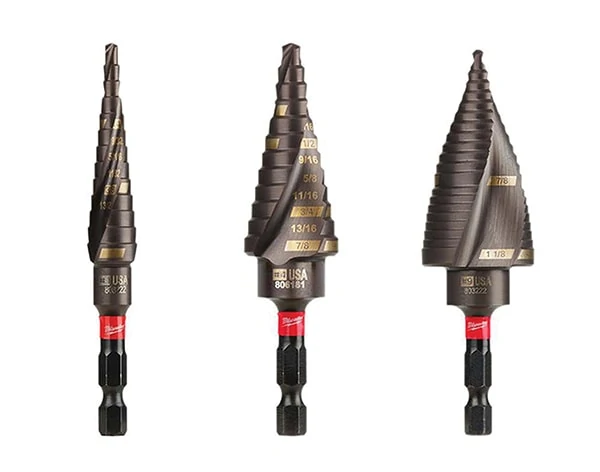
Cone-shaped with a “staircase” profile, step bits can drill a wide range of hole sizes with a single drill bit. Step bits can bore metal, wood, plastic and PVC. Look for a step bit that automatically deburs the holes as it drills—a nice feature because burring can sometimes be a problem with standard step bits.
Auger Bits

Auger bits are great for boring deep holes to install plumbing or electrical lines. Because they’re intended for deep drilling, they feature a long, deep spiral flute to effectively remove chips. A common 7-inch auger bit can drill through three 2×4’s, although some versions, called ship augers, range in size up to 18 inches.
Glass and Tile Bits

Two types of bits are available for glass and tile drilling. Some glass-and-tile bits from have a spear-pointed carbide tip to reduce bit wander and bit walking. The carbide tip prevents bit cracking when using with hard materials. Available in a range of sizes, these spear bits provide smooth, accurate drilling in ceramic tile, marble, china, mirrors and glass. These are a good choice for drilling fastener holes in bathroom tile or wall mirrors.
A second concept for glass and tile, diamond-grit drill bits utilize a circular cutting edge, like a hole saw, to power through class 5 tile, marble, porcelain, granite, slate and glass quickly and cost effectively. To use freehand, position the bit at an angle to pilot the hole. Slowly begin the edge of the hole and gradually center the bit directly above, drilling down to eliminate the risk of drill-bit wander. As the bit drills through material, the hollow barrel of the bit creates a core that helps guide the drill and eliminates skating. These “wet drill bits” must be water-cooled when in use.
Masonry Bits
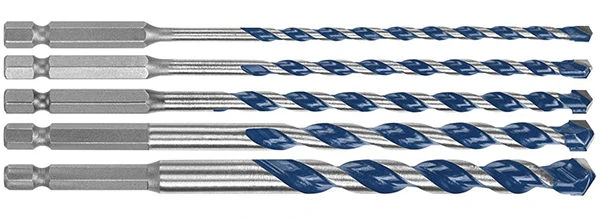
Masonry bits are a variation of the twist-bit design and are typically used with a hammer-drill for its high-impact action. They feature a chisel-like tungsten carbide tip to break up stone, brick or concrete, while the flutes pull back the chipped material. Because these bits occasionally get jammed with crushed masonry, it’s best to operate the hammer-drill with a pumping action. Masonry bits are excellent for installing wiring and plumbing in existing structures.



